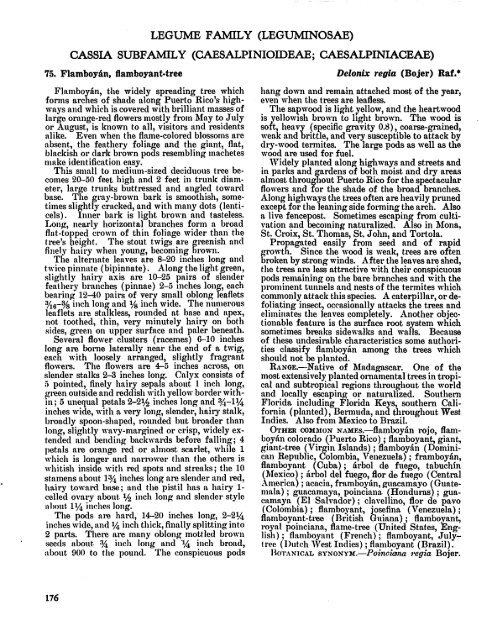Common Trees of Puerto Rico and the Virgin Islands
Common Trees of Puerto Rico and the Virgin Islands
Common Trees of Puerto Rico and the Virgin Islands
You also want an ePaper? Increase the reach of your titles
YUMPU automatically turns print PDFs into web optimized ePapers that Google loves.
LEGUME FAMILY (LEGUMINOSAE)<br />
CASSIA SUBFAMILY (CAESALPINIOIDEAE; CAESALPINTACEAE)<br />
75. Flamboyhn, flamboyant-tree Delonix regia (Bo jer) Raf.*<br />
Flambo bn, <strong>the</strong> widely spreading tree which hang down <strong>and</strong> remain attached most <strong>of</strong> <strong>the</strong> year,<br />
for~ns arc i es <strong>of</strong> shade along <strong>Puerto</strong> <strong>Rico</strong>'s high- even when <strong>the</strong> trees are leafless.<br />
ways ancl which is covered with brilliant mnsses <strong>of</strong> The sapwood is light yellow, <strong>and</strong> <strong>the</strong> heartwood<br />
large orange-red flowers mostly from May to July<br />
brown to 11ght brown. The \rood is<br />
or August, is known to all, visitors <strong>and</strong> residents<br />
gravity 0.8), coarse-grained,<br />
alike. Even when <strong>the</strong> flame-colored blossoms are<br />
<strong>and</strong> very susceptible to attack by<br />
absent, <strong>the</strong> fea<strong>the</strong>ry foliawe <strong>and</strong> <strong>the</strong> g~nnt, flat, dry-\rood termites. The large pods as well as <strong>the</strong><br />
blackish or dark brown resembling ~nachetes \rood are used for fuel.<br />
tnnke identification easy.<br />
Widely planted along highways <strong>and</strong> streets <strong>and</strong><br />
This snlall to medium-sized deciduous tree be- in parks <strong>and</strong> wardens <strong>of</strong> both moist <strong>and</strong> dry areas<br />
comes 20-50 feet high <strong>and</strong> 2 feet in trunk diam- almost throu&out <strong>Puerto</strong> <strong>Rico</strong> for <strong>the</strong> spectacular<br />
eter, lar e trunks buttressed arid a~lgled towtlrd flowers <strong>and</strong> for <strong>the</strong> shade <strong>of</strong> <strong>the</strong> broad branches.<br />
base. T f le gmy-brown bark is smoothish, some- Along highn~~ys <strong>the</strong> trees <strong>of</strong>ten are heavily pruned<br />
times slightly cracked, <strong>and</strong> with many dots (lenti- except for <strong>the</strong> leaning side forming <strong>the</strong> arch. Also<br />
cels). Inner ba+ is light brown <strong>and</strong> tasteless. a live fencepost. Sometimes escaping from culti-<br />
Long, nearly hor~zontal branches form a broad vation <strong>and</strong> kco~ning naturalized. Also in Mona,<br />
flat-topped crown <strong>of</strong> thin foliage wider than <strong>the</strong> St. Croix, St. Thomas, St. John, <strong>and</strong> Tortola.<br />
tree's height. The stout twigs are reenish <strong>and</strong> Pro agated easily from seed <strong>and</strong> <strong>of</strong> rapid<br />
finely hairy when young, becoming F ~rown. growt R . Since <strong>the</strong> wood is weak, trees are <strong>of</strong>ten<br />
The alternate leaves are 8-20 inches long <strong>and</strong> broken by strong winds. After <strong>the</strong> leaves are shed,<br />
twice pinntlte (bipinnate) . Along <strong>the</strong> light reen, <strong>the</strong> trees are less attractive with <strong>the</strong>ir conspicuous<br />
slightly haily axis are 10-25 pnirs <strong>of</strong> s P encler pods remaining on <strong>the</strong> bare branches <strong>and</strong> with <strong>the</strong><br />
fea<strong>the</strong>ry branches (pinnae) 2-5 inches long, mch prominent tunnels <strong>and</strong> nests <strong>of</strong> <strong>the</strong> termites which<br />
bearing 1240 pairs <strong>of</strong> very small oblong leaflets commonly attack this species. A caterpillar, or de-<br />
.?/,,-3/g inch long <strong>and</strong> l/s inch wide. The nunlerous foliating insect, occasionally attacks <strong>the</strong> trees <strong>and</strong><br />
leaflets nre stalkless, rounded at base <strong>and</strong> apex, elimiantes <strong>the</strong> leaves completely. Ano<strong>the</strong>r objecnot<br />
too<strong>the</strong>d, thin, very minutely hairy on both tionable feature is <strong>the</strong> surface mot system which<br />
sides, green on upper surface <strong>and</strong> paler beneath. sometimes bmlcs sidewalks <strong>and</strong> walls. Because<br />
Several flower clusters (r,zcemes) 6-10 ~nches <strong>of</strong> <strong>the</strong>se undesirable chamcteristics some authori-<br />
Ion are borne laterally near <strong>the</strong> end <strong>of</strong> a twig, ties classify flamboyitn among <strong>the</strong> trees which<br />
eacl f with loosely arranged, slightly fragrant should not be planted.<br />
flom-en. The flowers are 4-5 inches across, on RANGE.-Native <strong>of</strong> Madagascar. One <strong>of</strong> <strong>the</strong><br />
slender stnlks 2-3 inches long. Calyx consists <strong>of</strong> most extensively planted ornamental trees in tropi-<br />
5 pointed, finely hairy sepals tibout 1 inch long, cal <strong>and</strong> subtropical regions throughout <strong>the</strong> world<br />
(*reen outside <strong>and</strong> reddish with yellow border with- <strong>and</strong> locally escaping or naturalized. Sou<strong>the</strong>rn<br />
:I; 5 unequal petals 2-2% inches long <strong>and</strong> %-I% Florida including Florida Keys, sou<strong>the</strong>rn Caliinches<br />
wide, with a very long, slender, hairy stalk, fornia (planted), Bermuda, <strong>and</strong> tl~mughout West<br />
broadly spoon-sllnped, rounded but broader than Indies. Also from Mexico to Brzil.<br />
long, sliglltly wavy-margined or crisp, widely ex- OTHER ~MJLON NAMES.-flamboyin rojo, fl,mtencled<br />
<strong>and</strong> bending back~vards before falling; 4 boydn colorado (<strong>Puerto</strong> <strong>Rico</strong>) ; flamboyant, giant,<br />
petals are orange red or alnlost scarlet, while 1 giant-tree (<strong>Virgin</strong> Isl<strong>and</strong>s) ; flamboyin (Domini-<br />
\vhich is longer <strong>and</strong> narrower tllnn <strong>the</strong> o<strong>the</strong>~s is can Republic, Colombia, Venezuela) ; fmmboyiin,<br />
11-hitish inside wit11 red spots <strong>and</strong> streaks; <strong>the</strong> 10 flamboyant (Cuba) ; Arb01 de fuego, tabuchin<br />
stamens about 1% inches long are slender <strong>and</strong> 14, ; Arb01 del fuego, flor de fuego (Central<br />
hairy toward btlse; <strong>and</strong> tlle pistil has n haiiy<br />
!!!%i~] ; acacia, fmmboyhn, gl~acamayo (Guate-<br />
1-<br />
mala) ; guacamaya, poinciana (Honduras) ; guacelled<br />
ovary about, l/z inch long <strong>and</strong> slender style cttmaya (El Salvador) ; cla~ellino, flor de pavo<br />
;~l)out 1% inches long.<br />
(Colombia) ; flamboyant, josefina (Venezuela) ;<br />
The pods tire hard, 14-20 inches long, Z2% flnmboyant-tree (British Gniana) ; flamboyant,<br />
inches wide, ttnd inch thick, finally splitting into royal poinciana, flame-tree (United States, Eng-<br />
2 parts. There are many oblong mottled brown lish) ; flamboyttnt (French) ; flamboyant, Julyseeds<br />
:tbout. yl iiicll lorig ttnd I/q inch broad, tree (1)utch 7ITest Indies) ; fln~nboyant (Brazil).<br />
itbout 000 to tlle pound. The conspicuous pods I~OTANICAL s~-~o~~~.-Poincbna ?*egia Bojer.

















